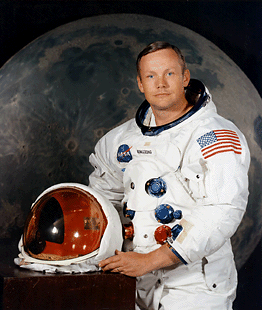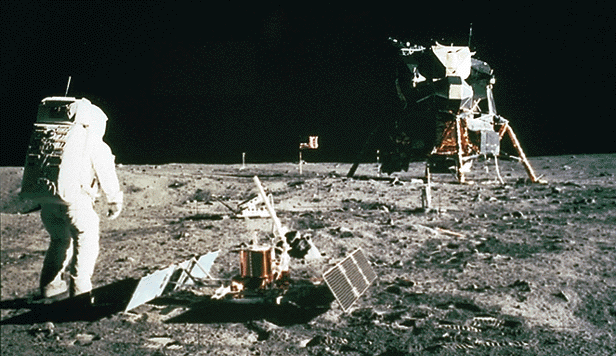First Moonwalker Neil Armstrong Dead at 82
August 27, 2012
Astronaut Neil Armstrong, the first human being to set foot on a celestial body beyond Earth, died on Saturday, August 25, from complications resulting from heart surgery. On July 20, 1969, millions of thrilled and anxious people around the world watched on television as Armstrong stepped down onto the moon from the Apollo 11 lunar module Eagle. The landing was one of the greatest feats in the history of exploration. “That’s one small step for a man, one giant leap for mankind,” Armstrong radioed back to NASA’s mission control. (The word a was lost in radio transmission.) In a statement released after Armstrong’s death, President Barack Obama said that Armstrong and his crew [Buzz Aldrin and Michael Collins] “carried with them the aspirations of an entire nation” and praised Armstrong as an American hero.

Neil A. Armstrong became the first person to set foot on the moon. (NASA)
Before commanding Apollo 11, Armstrong had made one previous trip to space, on Gemini 8 with David R. Scott in 1966. The two astronauts performed the first successful docking of two vehicles in space—the Gemini 8 and an uninhabited Agena rocket. Other Apollo craft had orbited the moon, but Apollo 11 was the first mission with the directive to “Perform a manned lunar landing and return.” The mission was the culmination of a 10-year race to the moon between the United States and the then-Soviet Union, its chief Cold-War enemy.
Armstrong and his Apollo 11 crew blasted off on July 16, 1969, and entered lunar orbit three days later. On July 20, the lunar module carrying Armstrong and Aldrin touched down at a lowland area called the Sea of Tranquility. Moments later, Armstrong radioed back his famous announcement: “Houston, Tranquility Base here. The Eagle has landed.” About 6 ½ hours later, Armstrong opened the lander’s hatch and descended a ladder to the surface. During their moonwalk, which lasted 2 hours and 19 minutes, Armstrong and Aldrin set up scientific instruments and a television camera. They also collected rock samples, which were later dated to 3.7 billion years ago. The Apollo command module splashed down safely in the Pacific Ocean on July 24.

The first people on the moon were U.S. astronauts Neil A. Armstrong, who took this picture, and Buzz Aldrin, who is pictured next to a seismograph. A television camera and a United States flag are in the background. Their lunar module, Eagle, stands at the right. (NASA)
Armstrong left NASA in 1970, becoming a professor at the University of Cincinnati and then chairman of the board for a company that developed software for flight scheduling. He rarely gave interviews. But in recent years, he spoke out for more piloted missions to the moon. Armstrong’s family, in an announcement of his death, said, “For those who may ask what they can do to honor Neil, we have a simple request. Honor his example of service, accomplishment and modesty, and the next time you walk outside on a clear night and see the moon smiling down at you, think of Neil Armstrong and give him a wink.”
Additional World Book articles:
- Space exploration
- Space exploration 1968 (a Back in Time article)
- Space exploration 1969 (a Back in Time article)
- Space exploration 1971 (a Back in Time article)


